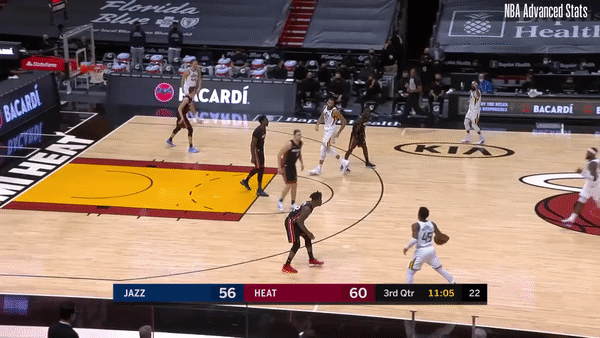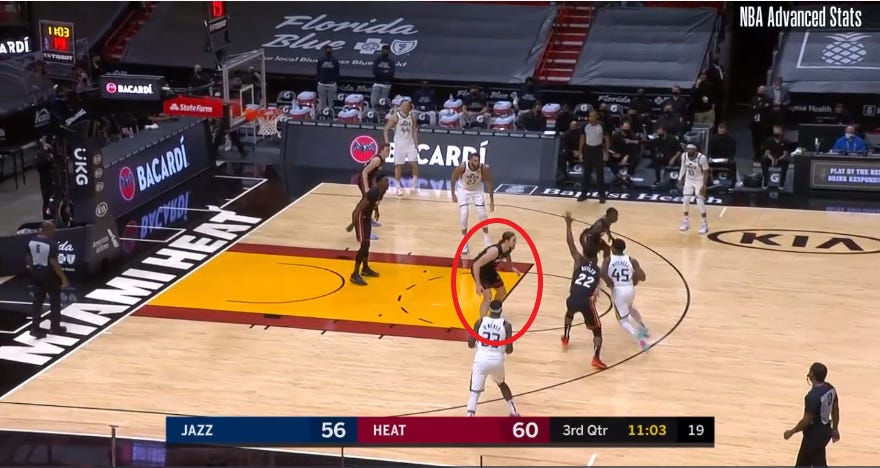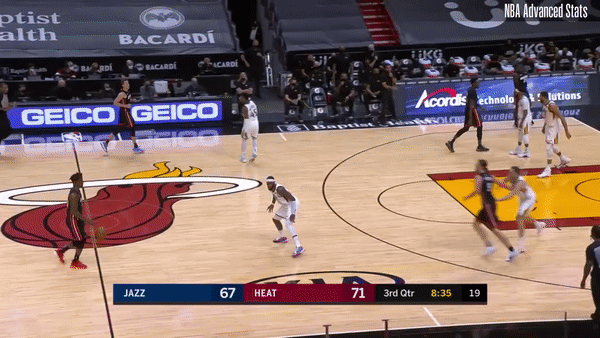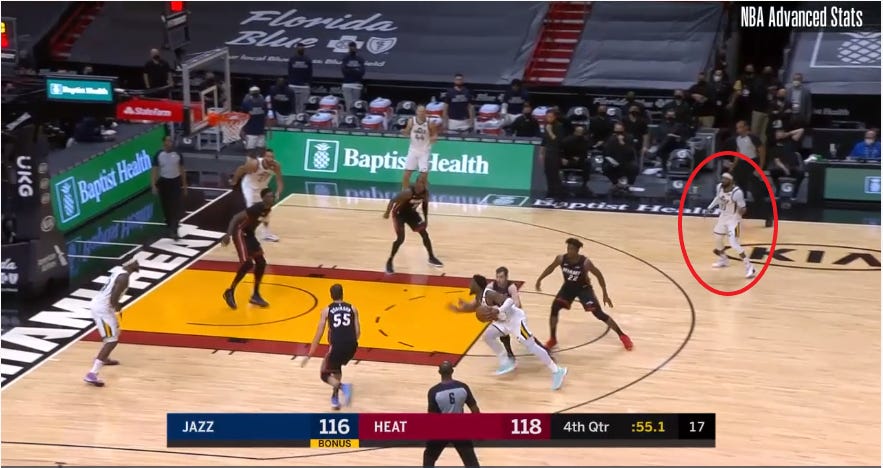This is the third in a recurring series; in previous installments, I looked at Bucks-Pelicans and Nets-Clippers matchups. I would love suggestions/requests for games that you would like to see featured in this space going forward.
It’s a shame that the Utah Jazz’s February 26th game visiting the Miami Heat did not air on national tv. This was one of the best games of the season so far: two rightfully lauded coaches making adjustments on-the-fly, both teams hunting out mismatches, counters to counters, and tough shots being taken and made. Aside from the two Jazz All Stars, this game also featured arguably the three best players to miss out on an All Star berth in Bam Adebayo, Jimmy Butler, and Mike Conley1. Butler in particular looked every bit the star that he was in the bubble. Let’s get to it.
Quarter 1: The Bam-and-Jimmy Show
Both the Jazz and the Heat leave opponents with very little margin for error. As Steve Jones Jr. has pointed out on multiple occasions, the Jazz are very tough to stop once they get a defense rotating. For their part, the Heat are merciless when they catch an opponent napping for even a second. Miami is second in the league in frequency of cuts per game and Kelly Olynyk opens the scoring when he cuts behind Royce O’Neal.
The story of the first quarter though was the Bam Adebayo-Jimmy Butler pick and roll. On three straight plays below, Bam scores on a short mid-range floater or jump shot, but each comes with a subtle variation on the same basic action. Each time, Bam stops short on his roll and it seems to be by design. First, Butler gets Gobert (playing drop coverage) back on his heels; with O’Neal rushing back to get to Butler, Bam gets the space he needs.
I love the craft from Jimmy there to get O’Neal on his hip before faking him into rushing past.
On the next play down, Butler rejects Bam’s screen and gets a step on O’Neal, drawing Gobert’s help in the drop and again getting Bam the floater.
Finally, Butler gets deep in the paint to suck Gobert all the way in, only this time O’Neal is ready and switches onto Bam in time…only for Bam to make a tough, contested mid-ranger.
And really, those shots perhaps summed up the biggest takeaway from the game: The Heat took and made a lot of tough shots. Indeed, the types of shots that the Jazz prefer to concede to teams over others. Per Cleaning the Glass, a third of the Heat’s shots came in that short mid-range area and they converted on 68% of them! This from a team that has converted under 40% from that area on the season, putting them in the bottom five of the league.
Heck, here is a freeze frame of a shot that Bam made in the third quarter:
And this was his shot chart on the night:
Here’s a play from early in the second quarter where Butler scores on a tough floater:
Butler is shooting 29% on shots from that distance on the season, in the bottom quartile of the league per Cleaning the Glass.
As has been well documented, the Jazz follow the dictum of sealing off the rim and running teams off the three point line and if something has to give, they are happy for it to be the mid-range. Only the Washington Wizards have allowed a higher proportion of opponent shots in the mid-range area per CTG. It is important to note that this isn’t a case of the Jazz just allowing teams to waltz into open mid-range looks; even with their bigs dropping back, they back them to step out and contest shots even as the Jazz guards and wings fight over to put in reasonable rearview contests. Many of the shots the Heat attempted in this game were either contested, or just tough. Credit the Heat with making them (Bam, Jimmy, and Goran Dragic in particular), but Jazz fans might want to shrug and chalk some of this loss up to bad luck spoiling good process.
On the other end, the Heat started mixing up the defensive coverages that they were showing the Jazz. On their last four defensive possessions in the first, they went man, 2-3 zone, 2-3 zone, man, also varying when they switched and when they didn’t. The Jazz still managed 30 points in the quarter, but Erik Spoelstra was dipping into his bag early.
Quarter 2: Duncan Robinson Has Levels
Duncan Robinson was one of the big success stories of the 2019-20 Miami Heat season. His 3 point shooting numbers have tailed off a bit from last season’s scorching 44.6% on over 8 attempts per game, but he is still shooting over 39% on a similar number of attempts this season. Some of this might be expected regression; last season Robinson shot 41% on 3-pointers that NBA.com advanced stats classifies as “tight” (closest defender 2-4 feet away) and nearly 38% on “very tight” (closest defender less than 2 feet away). This season, the corresponding figures are 35% and 20% respectively.
(Side bar: Those numbers this season for Stephen Curry? 40.4% and a scarcely believable 53.8%. There are great shooters and then there is Steph.)
The proportion of Robinson’s attempts that are tightly contested has also ticked up from last season, which isn’t surprising as opponents have wised up. Even towards the end of last season, it was not uncommon to see defenders aggressively top locking Robinson, as Donovan Mitchell did throughout this game. On this first quarter play, Robinson tries to spring free and gets called for an offensive foul.
The Heat and Robinson have taken all this in stride and found a variety of ways in which to get Robinson good looks. Robinson might pitch the ball to a teammate and fake towards a handoff before relocating in the other direction; defenders get caught leaning the wrong way to deny the handoff and that’s all the daylight Robinson needs to receive the ball back and launch.
Given how potent Robinson has been coming off those handoffs, can you blame Mike Conley there? There’s more than a hint of Steph and Draymond Green in that play.
Another standard counter to top-locking is for the shooter to cut towards the basket, oftentimes leading to a layup. Bam in particular has become adept at finding Robinson on those cuts.
Robinson is averaging more paint touches this season and more touches overall per nba.com advanced stats.
A personal favorite is when Robinson uses his man to muck things up enough to spring a teammate open. Here in an early early third quarter sequence, he uses Mitchell’s commitment to denying the Butler pin down to widen the obstacle that Bojan Bogdanovic has to traverse in closing out on Kelly Olynyk.
What initially appeared to be a pin down for Robinson turns into an extra large screen for the open Olynyk 3.
Quarter 3: Mismatch Hunting
This game was yet another reminder that isolated highlights will often miss the progression of action and reaction that inevitably occurs when two good teams face off. Early in the third quarter, Donovan Mitchell runs a pick and roll with Royce O’Neal. Whether by design or not, Olynyk drops and Jimmy Butler switches out late onto O’Neal.
Mitchell makes the smart read there to find O’Neal open on the wing, never mind the miss. Next time down the floor, Mitchell runs a pick and roll with Rudy Gobert, only this time it is Bam Adebayo defending the roller and he is up at the level of the screen, so Olynyk helps off of O’Neal to tag Gobert.
Mitchell should ideally be looking for the open O’Neal there, or even Gobert in the dunker’s spot since Olynyk rotates over early and Butler isn’t back in time to contest the lob.
To Mitchell’s credit, he adjusts quickly. On the subsequent play, he pulls back on the drive, looks off Gobert, and finds O’Neal wide open for the 3.
Seeing that opening is a function of recognizing the domino effect engendered by how the Heat are defending the pick and roll. Contrast Olynyk in the drop with Bam at the level of the screen:
Olynyk seems to be the designated helper regardless of where he is, perhaps because he is taller than Robinson (who should have nominal help responsibilities here), something else that Mitchell recognizes. This is some of the growth in his play, his missteps at the end of this game notwithstanding. But more on that in a bit.
This game had a playoff feel in some part because both teams zeroed in on and sought out the weak link in their opponent’s defense. The Heat went to the Butler-Olynyk pick and roll on consecutive plays to get Bojan Bogdanovic on Butler.
Butler had no trouble getting a step on Bogdanovic and drew Bogdanovic’s fourth foul four minutes into the third.
Shout out to Bam’s cut there, which draws Gobert just far enough to leave Bogdanovic on an island.
On the other end, Utah was happy to return the favor as they repeatedly put Olynyk through the wringer. First, Mike Conley gets the switch with Olynyk out of a pick and roll with Royce O’Neal and has no trouble scoring.
The Jazz go back to the same play next time down the floor and this time Nunn tries peeling back onto Conley, leaving Olynyk with too much ground to make up to contest the O’Neal 3.
Third time’s the charm, but not for Olynyk: off the same action, O’Neal has no trouble driving past Olynyk’s hard closeout and makes the correct read to find Joe Ingles for an open 3 once the help is sucked in.
By the fourth consecutive play, Utah is just having fun as Ingles goes straight from the pitch to Conley into a screen on Kendrick Nunn. With Nunn behind the play and Ingles spotting up on the wing to keep Butler occupied, Olynyk finds himself back in the bad place.
There is something tragi-comic about Olynyk’s resigned look over to the weakside at the end of the play, as if to wonder who has his back.
Quarter 4: Room to Grow
I have praised Donovan Mitchell’s decision making in this space before, but the end of this game didn’t provide the best evidence of that. Off of a jump ball, Mitchell drove and kicked out to Conley on the wing, putting the Heat defense in rotation, eventually leading to an open Bogdanovic corner 3. There wasn’t enough of that Mitchell in crunch time. Next play down, Mitchell missed Bogdanovic open on the wing when Robinson hedged on the pick and roll; that play eventually stagnated and ended with a contested Bogdanovic miss.
The good: Mitchell’s first step is potent and he repeatedly gets a jump on his man. The bad: He doesn’t leverage the domino effect that follows enough. As noted above, the Jazz are at their best when they put defenses into rotation, but this game made me think that they still have an untapped margin there. For instance, after splitting the defense here and getting deep into the paint, Mitchell coughs up a tough, contested shot:
The Heat had been aggressively helping on Mitchell’s drives all game long and Mitchell has his pick of options there: Conley in the left corner, Gobert in the dunker’s spot as Bam rotates over, or with a little patience, Bogdanovic lifting to the right wing.
On some of these drives, I almost wish Mitchell would slow down just a bit and allow the whirling Jazz to present him with some options (like Bogdanovic above.) Here for instance, the simple pass to Conley could open Bogdanovic up on a subsequent pass for the corner 3:
Jimmy Butler is all the way in at the nail there, so a pass to Conley likely sends Andre Iguodala closing out, at which point the pass to Bogdanovic opens up for Conley. Not unlike the play earlier on off the jump ball when Mitchell’s drive opened up the swing-swing.
It might just be a matter of more patience; Mitchell is making these reads, he just doesn’t make them all the time. In games like this one, the misses may stand out more than the ones he gets right. Over time, that will change and I am a Mitchell believer.
Zone Buster
Remember that counter to the 2-3 zone that Utah and Dallas amongst others have busted out (scroll all the way down)? At the end of the first quarter in this one, it looked like the Jazz were going to run the same play with Joe Ingles and Jordan Clarkson screening the forwards in the Heat zone. Watch Ingles flip his screen to the outside and Clarkson slip the screen though.
It looks like the Heat are anticipating the inside screens and Dragic pulls in to the nail to cut off a Conley drive down the middle. The Jazz misdirection seems to sow just enough confusion whereby Dragic doesn’t close out on Clarkson. Counters to counters!
Conley was subsequently named an injury replacement for Devin Booker and I couldn’t be happier. He clearly wanted it and “best to never make an All Star team” is a badge of honor that quickly loses its sheen. And it couldn’t have happened to a nicer guy.




























